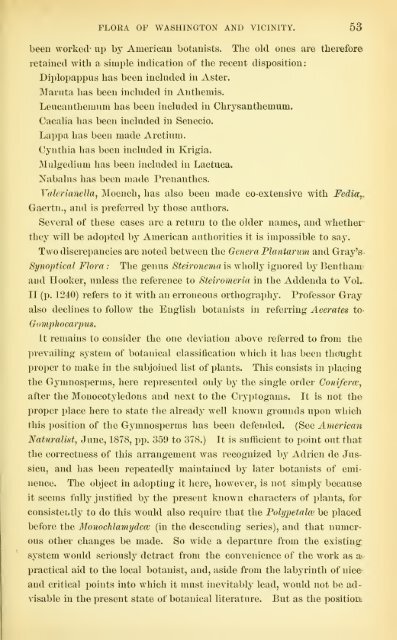Bulletin - United States National Museum - Smithsonian Institution
Bulletin - United States National Museum - Smithsonian Institution
Bulletin - United States National Museum - Smithsonian Institution
Create successful ePaper yourself
Turn your PDF publications into a flip-book with our unique Google optimized e-Paper software.
FLORA OF WASHINGTON AND VICINITY. 53<br />
been worked* up by American botanists. The old ones are therefore<br />
retained with a simple indication of the recent disposition<br />
Diplopappus has been included in Aster.<br />
Maruta has been included in Anthemis.<br />
Leucauthemum has been included in Chrysanthemum.<br />
Cacalia has been included in Seuecio.<br />
Lappa has been made Arctium.<br />
Cynthia has been included in Krigia.<br />
Mulgedium has been included in Lactuca.<br />
Nabalus has been made Prenanthes.<br />
YalcrianeUa^ Moench, has also been made co-extensive with Fedia^<br />
Gaertn., and is preferred by those authors.<br />
Several of these cases are a return to the older names, and whether<br />
they will be adopted by American authorities it is impossible to say.<br />
Two discrepancies are noted between the Genera Plantarum and Gray's<br />
Synoptical Flora : The genus Steironema is wholly ignored by Bentham<br />
and Hooker, unless the reference to Steiromeria in the Addenda to Vol.<br />
II (p. 1240) refers to it with an erroneous orthography. Professor Gray<br />
also declines to follow the English botanists in referring Acerates to<br />
Gomphocarjms.<br />
It remains to consider the one deviation above referred to from the<br />
prevailing system of botanical classification which it has been thought<br />
proper to make in the subjoined list of plants. This consists in placing<br />
the Gymnosperms, here represented only by the single order Gonifera\<br />
after the Monocotyledons and next to the Cryptogams. It is not the<br />
proper place here to state the already well known grounds upon which<br />
this position of the Gymnosperms has been defended. (See American<br />
Naturalist^ June, 1878, pp. 359 to 378.) It is sufficient to point out that<br />
the correctness of this arrangement was recognized by Adrien de Jus-<br />
sieu, and has been repeatedly maintained by later botanists of emi-<br />
nence. The object in adopting it here, however, is not simply because<br />
it seems fully justified by the present known characters of i)lants, for<br />
consistently to do this would also require that the Polypetalw be placed<br />
before the Monochlamydem (in the descending series), and that numer-<br />
ous other changes be made. So wide a departure from the existing:<br />
system would seriously detract from the convenience of the work as a<br />
practical aid to the local botanist, and, aside from the labyrinth of nic&<br />
and critical points into which it must inevitably lead, would not be ad-<br />
visable in the present state of botanical literature. But as the positioa<br />
:

















